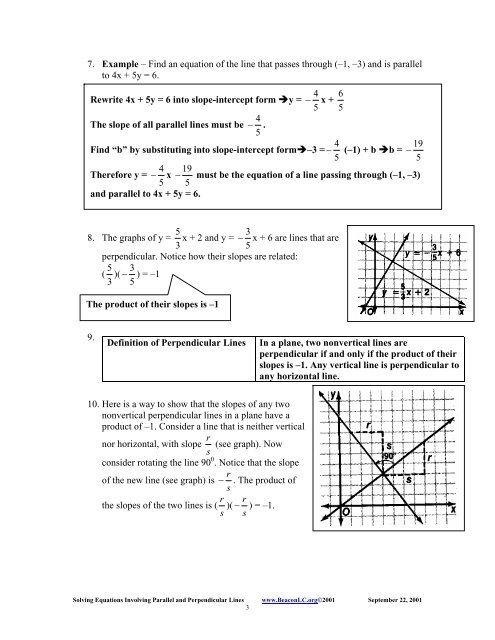Solving equations involving parallel and perpendicular lines examples
Solving equations involving parallel and perpendicular lines examples Solving equations involving parallel and perpendicular lines examples
4. Example – Find an equation of the line that passes through (4, 6) and is parallel to the line whose equation is y = 3 2 x + 5. The slope is 3 2 (notice that y = 3 2 x + 5 is in slope-intercept form. Use (4, 6) and the slope 3 2 to find the y-intercept. y = mx + b 2 Substitution Property 6 = ( )(4) + b 3 8 6 = +b 3 2 10 10 An equation of the line is y = x + = b 3 3 3 5. Thought Provoker – What is the relationship between the x- and y-intercepts of parallel lines? If the intercepts are nonzero, the ratio of the x- and y-intercepts of a given line is equal to the ratio of the x- and y-intercepts of any line parallel to the given line. 6. Example – Find an equation of the line that passes through (–1, 5) and is parallel to y – 5x = 1 Rewrite y – 5x = 1 into slope-intercept form y = 5x + 1 The slope of all parallel lines must be 5. Find “b” by substituting into slope-intercept form5 = 5(–1) + b b = 10 Therefore y = 5x + 10 must be the equation of a line passing through (–1, 5) and parallel to y – 5x = 1. Solving Equations Involving Parallel and Perpendicular Lines www.BeaconLC.org©2001 September 22, 2001 2
7. Example – Find an equation of the line that passes through (–1, –3) and is parallel to 4x + 5y = 6. Rewrite 4x + 5y = 6 into slope-intercept form y = The slope of all parallel lines must be 4 − . 5 4 6 − x + 5 5 Find “b” by substituting into slope-intercept form–3 = 5 4 − (–1) + b b = 4 Therefore y = − x 5 and parallel to 4x + 5y = 6. 19 − 5 19 − must be the equation of a line passing through (–1, –3) 5 5 3 8. The graphs of y = x + 2 and y = − x + 6 are lines that are 3 5 perpendicular. Notice how their slopes are related: 5 3 ( )( − ) = –1 3 5 The product of their slopes is –1 9. Definition of Perpendicular Lines In a plane, two nonvertical lines are perpendicular if and only if the product of their slopes is –1. Any vertical line is perpendicular to any horizontal line. 10. Here is a way to show that the slopes of any two nonvertical perpendicular lines in a plane have a product of –1. Consider a line that is neither vertical nor horizontal, with slope s r (see graph). Now consider rotating the line 90 0 . Notice that the slope r of the new line (see graph) is − . The product of s r r the slopes of the two lines is ( )( − ) = –1. s s Solving Equations Involving Parallel and Perpendicular Lines www.BeaconLC.org©2001 September 22, 2001 3
- Page 1: Solving Equations Involving Paralle
- Page 5 and 6: 13. Example - Find an equation of t
- Page 7 and 8: Name:___________________ Date:_____
- Page 9 and 10: Name:___________________ Date:_____
- Page 11 and 12: Find an equation of the line that p
- Page 13 and 14: 22. (12, 6); 4 3 x + 2 1 y = 2 3 1
- Page 15 and 16: Student Name: __________________ Da
7. Example – Find an equation of the line that passes through (–1, –3) <strong>and</strong> is <strong>parallel</strong><br />
to 4x + 5y = 6.<br />
Rewrite 4x + 5y = 6 into slope-intercept form y =<br />
The slope of all <strong>parallel</strong> <strong>lines</strong> must be<br />
4<br />
− .<br />
5<br />
4 6<br />
− x +<br />
5 5<br />
Find “b” by substituting into slope-intercept form–3 = 5<br />
4<br />
− (–1) + b b =<br />
4<br />
Therefore y = − x<br />
5<br />
<strong>and</strong> <strong>parallel</strong> to 4x + 5y = 6.<br />
19<br />
−<br />
5<br />
19<br />
− must be the equation of a line passing through (–1, –3)<br />
5<br />
5 3<br />
8. The graphs of y = x + 2 <strong>and</strong> y = − x + 6 are <strong>lines</strong> that are<br />
3 5<br />
<strong>perpendicular</strong>. Notice how their slopes are related:<br />
5 3<br />
( )( − ) = –1<br />
3 5<br />
The product of their slopes is –1<br />
9.<br />
Definition of Perpendicular Lines<br />
In a plane, two nonvertical <strong>lines</strong> are<br />
<strong>perpendicular</strong> if <strong>and</strong> only if the product of their<br />
slopes is –1. Any vertical line is <strong>perpendicular</strong> to<br />
any horizontal line.<br />
10. Here is a way to show that the slopes of any two<br />
nonvertical <strong>perpendicular</strong> <strong>lines</strong> in a plane have a<br />
product of –1. Consider a line that is neither vertical<br />
nor horizontal, with slope s<br />
r (see graph). Now<br />
consider rotating the line 90 0 . Notice that the slope<br />
r<br />
of the new line (see graph) is − . The product of<br />
s<br />
r r<br />
the slopes of the two <strong>lines</strong> is ( )( − ) = –1.<br />
s s<br />
<strong>Solving</strong> Equations Involving Parallel <strong>and</strong> Perpendicular Lines www.BeaconLC.org©2001 September 22, 2001<br />
3



